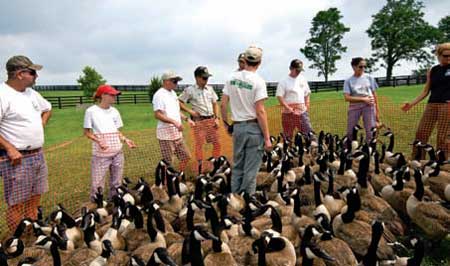June Is Canada Goose Round-Up Time


Kentucky –-(Ammoland.com)- Wildlife Division staff from the Northeast, Bluegrass and Southeast regions, along with assistance from Fisheries, Administrative Services, Information and Education and some enthusiastic volunteers herded, corralled and/or tackled about 2,000 Canada geese during this summer’s banding campaign.
During the last two weeks of June each year, KDFWR staff from the various divisions work together to band birds from Kentucky’s resident Canada goose population. Often referred to as Giant Canada geese (Branta Canadensis maxima) and once thought extinct, these birds have been restored across all their former range in North America.
Banding is done during late June and early July when adult geese are flightless because of the wing molt and before this year’s young can fly. Biologists use a variety of techniques including Jon boats on Cave Run Lake, trucks, ropes and foot traffic on Minor Clark Fish Hatchery, and a combination of radio-controlled boats and kayaks on central Kentucky horse farms to herd molting adults and young geese into locations where they can be trapped and banded.
Once the birds are corralled, biologists begin the process of aging and sexing each bird before placing a uniquely coded band around the leg and releasing the bird back on site. In addition to placing new bands on birds without bands, we record the band number of other geese already wearing leg bands from previous years. Often John Brunjes and Rocky Pritchert will use this opportunity to teach new staff as well as anyone else who may be interested to learn how to age and sex a goose.
This is an excellent hands on opportunity that often leaves its participants a little greener than when they began. The information collected from over 20 years of banding resident geese allows the state’s waterfowl biologists to monitor harvest, annual survival and movements of Kentucky’s birds across the state and throughout the flyway and North America.
Over the years through banding, we have seen the importance of Kentucky’s resident Canada geese increase to the state’s waterfowl hunters. In 1990, less than 5 percent of Kentucky’s Canada goose harvest consisted of resident birds and 95 percent from populations that nested on the tundra regions of James and Hudson Bay.
Today, about 45 percent of the state’s harvest is comprised of resident birds and over 80 percent of our total harvest consists of both Kentucky resident geese and resident geese from our neighboring states and Ontario. Banding information has permitted biologists to set longer seasons for Kentucky goose hunters because of knowledge that there will be little impact on less abundant migrant Canada goose populations.
Much of this would not be possible without the annual Kentucky goose round-ups.
